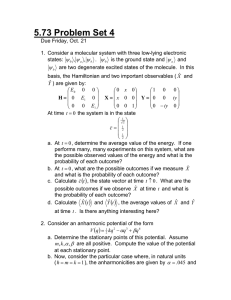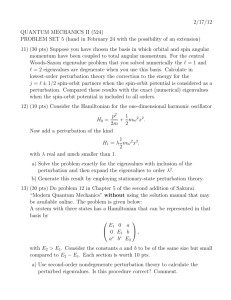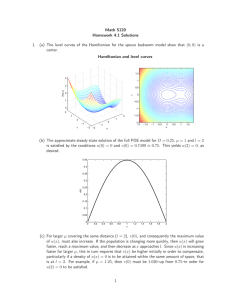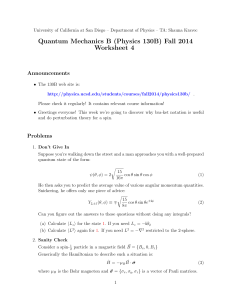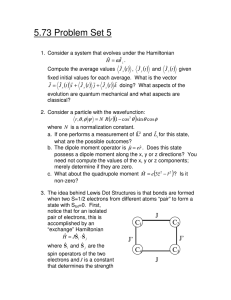( ) X. Perturbation Theory
advertisement
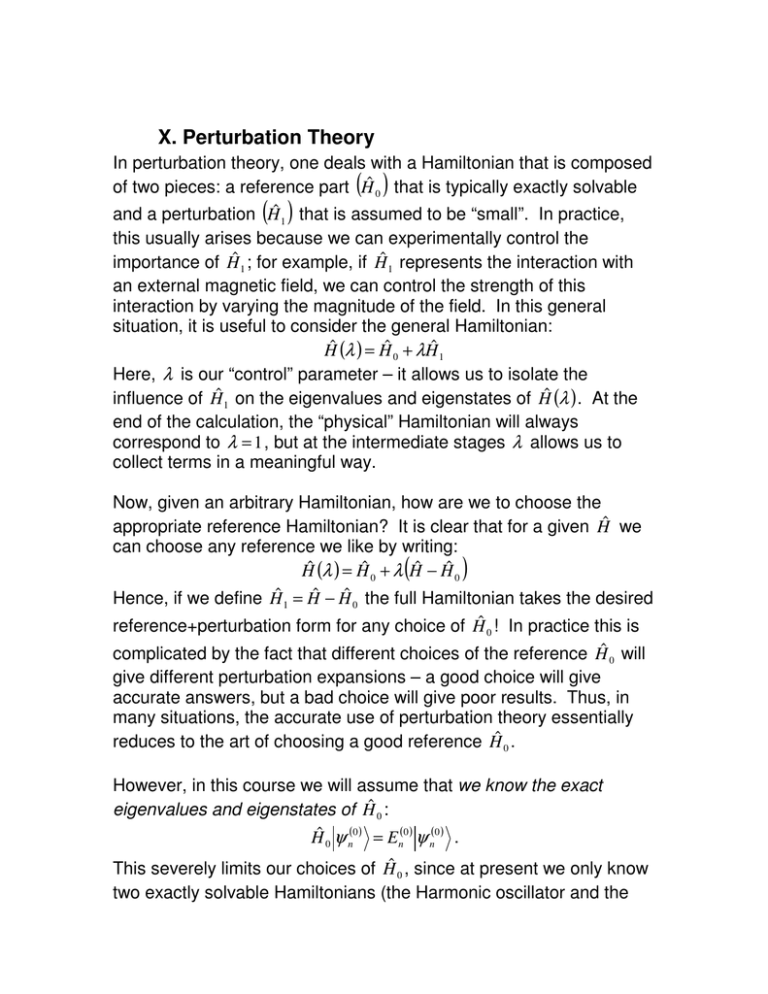
X. Perturbation Theory In perturbation theory, one deals with a Hamiltonian that is composed of two pieces: a reference part Ĥ 0 that is typically exactly solvable ( ) ( ) and a perturbation Ĥ 1 that is assumed to be “small”. In practice, this usually arises because we can experimentally control the importance of Ĥ 1 ; for example, if Ĥ 1 represents the interaction with an external magnetic field, we can control the strength of this interaction by varying the magnitude of the field. In this general situation, it is useful to consider the general Hamiltonian: Hˆ (λ ) = Hˆ 0 + λHˆ 1 Here, λ is our “control” parameter – it allows us to isolate the influence of Ĥ 1 on the eigenvalues and eigenstates of Ĥ (λ ) . At the end of the calculation, the “physical” Hamiltonian will always correspond to λ = 1 , but at the intermediate stages λ allows us to collect terms in a meaningful way. Now, given an arbitrary Hamiltonian, how are we to choose the appropriate reference Hamiltonian? It is clear that for a given Ĥ we can choose any reference we like by writing: Hˆ (λ ) = Hˆ 0 + λ Hˆ − Hˆ 0 ( ) Hence, if we define Hˆ 1 = Hˆ − Hˆ 0 the full Hamiltonian takes the desired reference+perturbation form for any choice of Ĥ 0 ! In practice this is complicated by the fact that different choices of the reference Ĥ 0 will give different perturbation expansions – a good choice will give accurate answers, but a bad choice will give poor results. Thus, in many situations, the accurate use of perturbation theory essentially reduces to the art of choosing a good reference Ĥ 0 . However, in this course we will assume that we know the exact eigenvalues and eigenstates of Ĥ 0 : Hˆ 0 ψ n(0 ) = En(0 ) ψ n(0 ) . This severely limits our choices of Ĥ 0 , since at present we only know two exactly solvable Hamiltonians (the Harmonic oscillator and the piecewise constant potential). Hence, every problem we treat will look like (Harmonic oscillator + other terms) or (step potential + other terms). It should be stressed that this is not a necessary assumption to apply perturbation theory; one can also formulate perturbative expansions based on approximately solvable reference Hamiltonians, but we will not treat this case in this course. Given that we know the eigenstates and eigenvalues of Ĥ 0 , we now seek to understand how Ĥ 1 influences these eigenvalues and eigenstates. Thus, we are interested in the solutions of the equation: Hˆ (λ )ψ n (λ ) = En (λ )ψ n (λ ) Now, recall that our physical picture is that Ĥ 1 has a “small” influence on Ĥ 0 . This can be enforced by examining the behavior of the eigensystem for small λ . To this end, we assume that we can expand the eigenstates and eigenvalues in a Taylor series in λ : ψ n (λ ) = ψ n(0 ) + λ ψ n(1) + λ2 ψ n(2 ) + ... En (λ ) = En(0 ) + λEn(1) + λ2 En(2 ) + ... If we plug these expansions into the eigenvalue equation, we obtain Hˆ 0 + λHˆ 1 ψ n(0 ) + λ ψ n(1) + λ2 ψ n(2 ) + ... = ( )( ) (E ( ) + λE ( ) + λ E ( ) + ...)(ψ ( ) 0 n 1 n 2 2 n 0 n + λ ψ n(1) + λ2 ψ n(2 ) + ... ) Now, this equation must be true for all λ . Therefore, we can equate the coefficients of λ0 , λ1 , λ2 …. If we expand the products and collect terms, we find: 0th order ( λ0 ): Hˆ 0 ψ n(0 ) = En(0 ) ψ n(0 ) 1st order ( λ1 ): Hˆ 0 ψ n(1) + Hˆ 1 ψ n(0 ) = En(1) ψ n(0 ) + En(0 ) ψ n(1) 2nd order ( λ2 ): Hˆ 0 ψ n(2 ) + Hˆ 1 ψ n(1) = En(2 ) ψ n(0 ) + En(1) ψ n(1) + En(0 ) ψ n(2 ) etc… The 0th order relation is trivially satisfied because ψ n(0 ) are the eigenstates of the reference Hamiltonian. Our task now is to obtain closed form expressions for the other unknowns (i.e. En(1) , ψ n(1) , En(2 ) ... ) in these equations. We do this by projecting the equations onto cleverly chosen states. For example, if we multiply the 1st order equation by ψ m(0 ) on both sides, we obtain: ψ m(0 ) Hˆ 0 ψ n(1) + ψ m(0 ) Hˆ 1 ψ n(0 ) = ψ m(0 ) En(1) ψ n(0 ) + ψ m(0 ) En(0 ) ψ n(1) ⇒ ψ m(0 ) Em(0 ) ψ n(1) + ψ m(0 ) Hˆ 1 ψ n(0 ) = ψ m(0 ) En(1) ψ n(0 ) + ψ m(0 ) En(0 ) ψ n(1) ⇒ Em(0 ) ψ m(0 ) ψ n(1) + ψ m(0 ) Hˆ 1 ψ n(0 ) = En(1) ψ m(0 ) ψ n(0 ) + En(0 ) ψ m(0 ) ψ n(1) ⇒ Em(0 ) ψ m(0 ) ψ n(1) + ψ m(0 ) Hˆ 1 ψ n(0 ) = En(1)δ mn + En(0 ) ψ m(0 ) ψ n(1) where, in the last line, we have used the fact that ψ n(0 ) form an orthonormal basis. To deal with the Kronecker delta, we treat the m = n and m ≠ n cases separately. For m = n we obtain: En(0 ) ψ n(0 ) ψ n(1) + ψ n(0 ) Hˆ 1 ψ n(0 ) = En(1)δ nn + En(0 ) ψ n(0 ) ψ n(1) ⇒ ψ n(0 ) Hˆ 1 ψ n(0 ) = En(1) And thus, we obtain an expression for the first order energy En(1) that simply requires sandwiching the perturbing Hamiltonian between the zeroth order eigenstates. In the m ≠ n case, we obtain: Em(0 ) ψ m(0 ) ψ n(1) + ψ m(0 ) Hˆ 1 ψ n(0 ) = En(1)δ mn + En(0 ) ψ m(0 ) ψ n(1) ⇒ ψ m(0 ) Hˆ 1 ψ n(0 ) = (En(0 ) − Em(0 ) ) ψ m(0 ) ψ n(1) ψ m(0 ) Hˆ 1 ψ n(0 ) = ψ m(0 ) ψ n(1) (m ≠ n ) − Em ) What does this last expression mean? Note that if we wanted to expand ψ n(1) in terms of the eigenstates of Ĥ 0 we would write: ⇒ (E (0 ) (0 ) n ψ n(1) = ∑ ψ m(0 ) ψ m(0 ) ψ n(1) . m The unknowns in this expansion are the overlap coefficients ψ m(0 ) ψ n(1) . By comparison with the previous expression, we see that we now know all of these coefficients in terms of matrix elements of Ĥ 1 and the zeroth order eigenvalues. The one exception is ψ n(0 ) ψ n(1) . To fix this coefficient, we constrain the norm of ψ n (λ ) . The normalization of ψ n (λ ) does not influence the out come of any experiment. However, it is convenient to enforce intermediate normalization: ( 1 = ψ n(0 ) ψ n (λ ) = ψ n(0 ) ψ n(0 ) + λ ψ n(0 ) ψ n(1) + λ2 ψ n(0 ) ψ n(2 ) + ... ) Note that this is not the same as conventional normalization, and so ψ n (λ ) ψ n (λ ) ≠ 1 . However, if we enforce intermediate normalization for all λ , we can equate the coefficients of different powers of λ . Thus, 0th order ( λ0 ): 1 = ψ n(0 ) ψ n(0 ) kth order ( λk , k > 0 ): 0 = ψ n(0 ) ψ n(k ) Thus, in intermediate normalization, ψ n(0 ) ψ n(1) is zero. We therefore know all the overlaps ψ m(0 ) ψ n(1) and we can therefore expand the first order wavefunction in terms of the zeroth order eigenstates: (0 ) ˆ (0 ) (1) (0 ) ψ m H 1 ψ n ψn = ∑ ψm (En(0 ) − Em(0) ) . m≠n This expression immediately gives us a quantitative measure that lets us assess whether Ĥ 1 is really “small”: if ψ m(0 ) Hˆ 1 ψ n(0 ) << (En(0 ) − Em(0 ) ) for all m, n then the first order wavefunction will be small. In this case our qualitative picture of perturbation theory will be correct. Now, in practice the first order energy correction is very often zero either because of symmetry or because Ĥ 0 has been chosen very cleverly. In this case, it becomes necessary to go to second order in the λ expansion to determine how Ĥ 1 affects the eigenvalues. That is, it becomes necessary to compute En(2 ) . To obtain this, we project the λ2 equation on to ψ n(0 ) : ψ n(0 ) Hˆ 0 ψ n(2 ) + ψ n(0 ) Hˆ 1 ψ n(1) = ψ n(0 ) En(2 ) ψ n(0 ) + ψ n(0 ) En(1) ψ n(1) + ψ n(0 ) En(0 ) ψ n(2 ) ψ n(0 ) En(0 ) ψ n(2 ) + ψ n(0 ) Hˆ 1 ψ n(1) = ψ n(0 ) En(2 ) ψ n(0 ) + ψ n(0 ) En(1) ψ n(1) + ψ n(0 ) En(0 ) ψ n(2 ) ⇒ ψ n(0 ) Hˆ 1 ψ n(1) = E n(2 ) ψ n(0 ) ψ n(0 ) + E n(1) ψ n(0 ) ψ n(1) 1 Hence, we obtain an expression for En(2 ) : 0 (2 ) (0 ) (1) ⇒ En = ψ n Hˆ 1 ψ n (0 ) = ψn ψ m(0 ) Hˆ 1 ψ n(0 ) ( ) 0 Hˆ 1 ∑ ψ m (0 ) (0 ) m≠n ( ) E − E n m ψ m(0 ) Hˆ 1 ψ n(0 ) ψ m(0 ) Hˆ 1 ψ n(0 ) = ∑ ψ n(0 ) Hˆ 1 ψ m(0 ) 2 (E ( ) − E ( ) ) = ∑ (E ( ) − E ( ) ) 0 n m ≠n En(2 ) = ∑ 0 m ψ m(0 ) Hˆ 1 ψ n(0 ) m ≠n 0 n 0 m 2 En(0 ) − Em(0 ) As an example of how we can apply this in practice, let’s look at the Hamiltonian: pˆ 2 1 ˆ + 2 mω 2 qˆ 2 + 12 δk qˆ 2 H= 2m Or, in reduced units ( m = = ω = 1 ): pˆ 2 1 2 1 Hˆ = + 2 qˆ + 2 δk qˆ 2 2 First, we identify Ĥ 0 and Ĥ 1 : m ≠n pˆ 2 1 2 ˆ H0 = + 2 qˆ Hˆ 1 = 12 δk qˆ 2 2 The zeroth order energy is just the Harmonic oscillator energy: En(0 ) = (n + 12 ) while the first order energy is En(1) = n 12 δk qˆ 2 n = 12 δk n qˆ 2 n = 12 δk (n + 12 ) and the second order energy is En = ∑ (2 ) n 12 δk qˆ 2 m En(0 ) − Em(0 ) m≠n = = 1 4 δk 2 = n 12 δk qˆ 2 n + 2 (n + 2 )(n + 1) En(0 ) − En(0+)2 2 + En(0 ) − En(0+)2 1 4 δk (n + 2 )(n + 1) 2 2 1 4 + δk n(n − 1) n 12 δk qˆ 2 n − 2 2 En(0 ) − En(0−)2 2 En(0 ) − En(0−)2 1 4 δk n(n − 1) 2 + −2 2 2 = − 18 δk (n + 12 ) However, we could have computed these in another way. Notice that our full Hamiltonian is still a Harmonic oscillator pˆ 2 1 ~ 2 2 ˆ H= + 2 ω qˆ 2 but with the effective frequency ω~ = 1 + δk . Thus, we can easily write down the exact eigenvalues of the full Hamiltonian for this simple case: En = ω~ (n + 12 ) = 1 + δk (n + 12 ) . If we expand this in a power series in δk : En = (n + 12 ) + 12 (n + 12 )δk − δk 2 18 (n + 12 ) + ... Comparing this with our expressions for the first and second order energy corrections, we see that En = En(0 ) + En(1) + En(2 ) + ... which is exactly what we would expect based on our assumption that En (λ ) = En(0 ) + λEn(1) + λ2 En(2 ) + ... Setting λ = 1 in the latter expression immediately yields the former. Note that this is really just a convenient way to check that we have done all the algebra right; in the general case, the exact eigenvalues will be unknown and the perturbative results will be our only guide. Now, the expressions above do not apply if the eigenstate we are interested in is degenerate with another eigenstate. In this case En(0 ) = Em(0 ) and the second order energy correction diverges! This, in turn, is related to the fact that, in general, the first order change in the energy is not well defined for a degenerate state: a state ψ n( 0' ) = a ψ n( 0) + b ψ m( 0) that is a linear combination of degenerate states is also an eigenstate with the same eigenvalue. However the first order energy change En(2' ) will typically be different from En(2 ) and Em(2 ) . Because of this ambiguity in the first derivative, the second derivative ends up being infinite. Looking at the second order energy expression, the only way this could possibly be avoided is if ψ m(0 ) Hˆ 1 ψ n(0 ) is also zero. It might seem very unlikely that this would happen but, as we are about to show, for any number of degenerate states we can always make it so that the matrix elements of Ĥ 1 are zero between different degenerate states. Assume we have k degenerate zeroth order states: ψ n(10 ) , ψ n(02 ) , ψ n(03 ) ,... ψ n(0k ) For which: Hˆ 0 ψ n(0j ) = E ψ n(0j ) where the energy, E , is the same for all j . Of course, any linear combination of the ψ n(0j ) is also an eigenstate with energy E and we want to exploit this ambiguity to force ψ n(0j ) Hˆ 1 ψ n(i0 ) to be zero for all i ≠ j . First note that, in the ψ n(0j ) basis, H 0 is proportional to the identity matrix: ψ n(10 ) Hˆ 0 ψ n(10 ) ψ n(10 ) Hˆ 0 ψ n(02 ) ... E 0 0 1 H 0 = ψ n(02 ) Hˆ 0 ψ n(10 ) ψ n(02 ) Hˆ 0 ψ n(02 ) ... = 0 E ... = E 0 0 ... ... ... 0 ... ... Thus, if we make a change of basis (i.e. replace each ψ n(0j ) linear combination of the ψ n(0j ) ) we find: 0 0 1 ... ... ... by some 1 H 0 ⇒ T H 0 T = T E1T = ET T = E1 Where, in the last step, we have used the fact that a change of basis is unitary. Thus, we see that H 0 is invariant to a change of basis that just mixes the degenerate levels. On the other hand H1 is not invariant to this change of basis. We therefore transform to the particular linear combination of the ψ n(0j ) (call it the ψ~n(0j ) basis) that † † † renders H1 diagonal. In this basis we have: ~ (0 ) ~ (0 ) ψ~n(10 ) Hˆ 0 ψ~n(20 ) ... E1 0 0 ψ n1 Hˆ 0 ψ n1 (0 ) ˆ ~ (0 ) (0 ) ˆ ~ (0 ) ~ ~ H1 = 0 E2 ... = ψ n2 H 0 ψ n1 ψ n2 H 0 ψ n2 ... 0 ... ... ... ... ... where, in the first step, we have used the fact that H1 is (by assumption) diagonal. Comparing the second and third expressions immediately shows that ψ~n(0j ) Hˆ 1 ψ~n(i0 ) = 0 if i ≠ j . The ψ~n(0j ) basis is the correct basis in which to apply perturbation theory, because the first order corrections are well defined. Essentially, when the states ψ n(0j ) are degenerate, even a tiny (infinitesimal) perturbation proportional to H1 causes the eigenstates to spontaneously shift to ψ~n(0j ) ; the original Hamiltonian does not distinguish between these states because they are degenerate, but H 0 +ε H1 breaks the degeneracy for any ε. It is therefore convenient to work in the ψ~n(0j ) basis from the outset. Further examination of the matrix representation of H1 shows that the proper first order correction is given by: ⇒ ψ~ (0 ) Hˆ ψ~ (0 ) = E (1) nj 1 nj nj That is, the correct first order energy is given by the standard expression, but using the new functions ψ~n(0j ) . One can go beyond this to formula re-write the second order energy as: ~ (0 ) Hˆ ψ~ (0 ) 2 ψ m 1 n En(2 ) = ∑ . (0 ) (0 ) En − Em m ≠n Here, the ψ~ (0 ) states are still eigenstates of Ĥ . However, within the n 0 subspace of degenerate eigenstates of Ĥ 0 , the ψ~n(0 ) are chosen so that the off-diagonal elements of Ĥ 1 vanish and one can therefore neglect these terms in the summation. Now, usually, the first order correction will be enough to break the degeneracy, in which case the second order energy is not needed. However, in extraordinary cases, the second order correction may be needed. Typically, a physical Ĥ 0 will have many different “blocks” of degenerate eigenvalues. To state this pictorially: 1 H0 = 2 In practice, one must deal with each of the degenerate sub-blocks separately; one must find the ψ~n(0 ) that diagonalize Ĥ 1 in each block and compute the second order energy correction for each state in the block in turn before moving on to the next block. Note that making a change of basis within one block (e.g. block 1) will not affect the first or second order energy for a state in another block (e.g. block 2). Hence, if you are only interested in states in, say, block 1, you do not need to worry about transforming the degenerate states in block 2.

